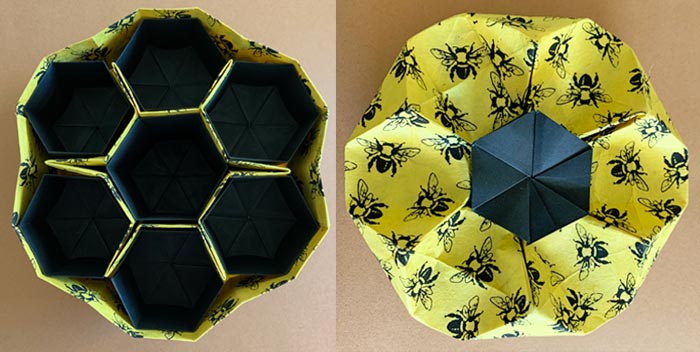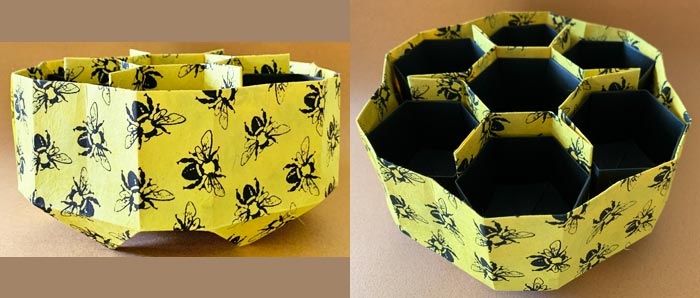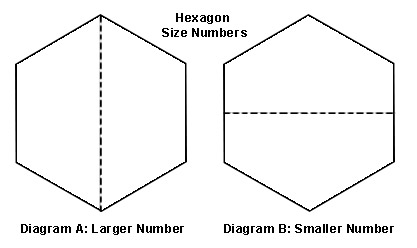



|
 |
*Note that two numbers are given for the size of the hexagon boxes used in this model.
The larger number is the measurement from a point at any corner to the point at the opposite corner.
(Diagram A)
The smaller number is the measurement from the center of any side to the center of the opposite
side. (Diagram B)
|
If you like the above, you may also like this:
|
Information About This Item
| Box ID #: | 5907 |
| Set ID #: | 5905 |
| Category: | Non-Modular -- Very Big Honeycomb-Shaped |
| Hex Box Size*: |
6.4 cm (2.5 in) and
5.5 cm (2.2 in)
|
| Comb Ring Size: |
Diameter - 18 cm (7.1 in)
|
| Height: |
Comb Ring - 9 cm (3.5 in)
Hex Boxes - 5 or 8.2 cm (2 or 3.2 in) |
| Style: | Non-Modular Honeycomb - 6 Sections |
| Designer: | Chrissy Pushkin (Paper Kawaii) |
| Design Source: | Learnigami Interlocking Boxes E-Book by Chrissy Pushkin (Paper Kawaii, 2020) >> Click here
YouTube Video >> Click here
|
| Paper Type: |
Honey Bee Print Lokta Origami Paper - Black on Yellow (GSP391-04)
Recollections Black Acid-Free Cardstock Paper - 12 in Square
|
| Sheet Size: | Hex Box - 13.4 x 21.6 or 20.7 x 21.6 cm (5.3 x 8.5 or 8.2 x 8.5 in) Rectangle | | | Comb Ring - 35.2 x 36.7 cm (13.9 x 14.5 in) Rectangle |
| Sheets Used: | 9 (2 - Comb Ring; 7 - Hex Boxes) |
| Paper Source: |
Mulberry Paper and More
Michaels Stores
|
| Comments: | This unusual and attractive container has two types of components: the basic comb ring, and 7 hexagonal boxes.
Here I have folded the comb from Lokta paper with black honeybees on yellow. Two rectangular sheets were folded and joined together, but the comb can also be made from just one very wide rectangular sheet, so this is not really a modular structure.
The comb ring has 6 sections and also an empty space at its center. A lidless hexagonal box sits in each of these 7 spaces. The central hex box is taller than the others because it rests directly on the table; the others rest on the floor of the ring, which is elevated on 6 small "feet."
I wanted black hex boxes, but the only black paper I had on hand was cardstock. It was heavier/stiffer than origami paper, which made executing small, precise folds difficult. I coped by setting aside Chrissy's method for making the hex boxes and using a simpler design instead. I also made my hex boxes shorter, to let more of my yellow paper show.
My simpler hex boxes are not as attractive on the inside as Chrissy's. Hers have a cute flower twist on the floor of the interior, which mine lack.
Regarding size: I wanted my finished model to be 1.75 times bigger than the one featured in Chrissy Pushkin's diagrams/instructions, but scaling up her model posed problems due to my limited paper supply.
Chrissy's comb ring calls for two A4 size sheets. She shows how to start making an 8-section version of the comb ring by folding each A4 size sheet into 16 equal sections, then trimming off two sections and working with the remaining 14. For the 6-section version, she suggests simply trimming another 3 sections off each 14 section sheet, to work with the remaining 11.
I couldn't use this fold-and-trim method because I didn't have enough honeybee paper to allow for the trimming. Instead, I figured out the sheet size needed to get 11 sections right from the start.
Folding 11 equal sections required a ruler and careful measuring; this was slower and more tedious than folding 16 equal sections and trimming. If you have enough paper to use Chrissy's method, go for it! Her approach is fast and easy! |
| |
|
Click here to see more boxes of this type
|
|



